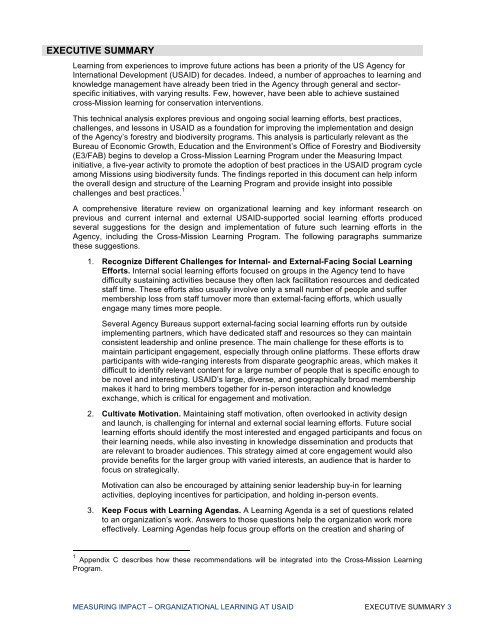MEASURING IMPACT Making Use of the Portfolio Organizational Learning at USAID
28Mzh2D
28Mzh2D
Create successful ePaper yourself
Turn your PDF publications into a flip-book with our unique Google optimized e-Paper software.
EXECUTIVE SUMMARY<br />
<strong>Learning</strong> from experiences to improve future actions has been a priority <strong>of</strong> <strong>the</strong> US Agency for<br />
Intern<strong>at</strong>ional Development (<strong>USAID</strong>) for decades. Indeed, a number <strong>of</strong> approaches to learning and<br />
knowledge management have already been tried in <strong>the</strong> Agency through general and sectorspecific<br />
initi<strong>at</strong>ives, with varying results. Few, however, have been able to achieve sustained<br />
cross-Mission learning for conserv<strong>at</strong>ion interventions.<br />
This technical analysis explores previous and ongoing social learning efforts, best practices,<br />
challenges, and lessons in <strong>USAID</strong> as a found<strong>at</strong>ion for improving <strong>the</strong> implement<strong>at</strong>ion and design<br />
<strong>of</strong> <strong>the</strong> Agency’s forestry and biodiversity programs. This analysis is particularly relevant as <strong>the</strong><br />
Bureau <strong>of</strong> Economic Growth, Educ<strong>at</strong>ion and <strong>the</strong> Environment’s Office <strong>of</strong> Forestry and Biodiversity<br />
(E3/FAB) begins to develop a Cross-Mission <strong>Learning</strong> Program under <strong>the</strong> Measuring Impact<br />
initi<strong>at</strong>ive, a five-year activity to promote <strong>the</strong> adoption <strong>of</strong> best practices in <strong>the</strong> <strong>USAID</strong> program cycle<br />
among Missions using biodiversity funds. The findings reported in this document can help inform<br />
<strong>the</strong> overall design and structure <strong>of</strong> <strong>the</strong> <strong>Learning</strong> Program and provide insight into possible<br />
1<br />
challenges and best practices.<br />
A comprehensive liter<strong>at</strong>ure review on organiz<strong>at</strong>ional learning and key informant research on<br />
previous and current internal and external <strong>USAID</strong>-supported social learning efforts produced<br />
several suggestions for <strong>the</strong> design and implement<strong>at</strong>ion <strong>of</strong> future such learning efforts in <strong>the</strong><br />
Agency, including <strong>the</strong> Cross-Mission <strong>Learning</strong> Program. The following paragraphs summarize<br />
<strong>the</strong>se suggestions.<br />
1. Recognize Different Challenges for Internal- and External-Facing Social <strong>Learning</strong><br />
Efforts. Internal social learning efforts focused on groups in <strong>the</strong> Agency tend to have<br />
difficulty sustaining activities because <strong>the</strong>y <strong>of</strong>ten lack facilit<strong>at</strong>ion resources and dedic<strong>at</strong>ed<br />
staff time. These efforts also usually involve only a small number <strong>of</strong> people and suffer<br />
membership loss from staff turnover more than external-facing efforts, which usually<br />
engage many times more people.<br />
Several Agency Bureaus support external-facing social learning efforts run by outside<br />
implementing partners, which have dedic<strong>at</strong>ed staff and resources so <strong>the</strong>y can maintain<br />
consistent leadership and online presence. The main challenge for <strong>the</strong>se efforts is to<br />
maintain participant engagement, especially through online pl<strong>at</strong>forms. These efforts draw<br />
participants with wide-ranging interests from dispar<strong>at</strong>e geographic areas, which makes it<br />
difficult to identify relevant content for a large number <strong>of</strong> people th<strong>at</strong> is specific enough to<br />
be novel and interesting. <strong>USAID</strong>’s large, diverse, and geographically broad membership<br />
makes it hard to bring members toge<strong>the</strong>r for in-person interaction and knowledge<br />
exchange, which is critical for engagement and motiv<strong>at</strong>ion.<br />
2. Cultiv<strong>at</strong>e Motiv<strong>at</strong>ion. Maintaining staff motiv<strong>at</strong>ion, <strong>of</strong>ten overlooked in activity design<br />
and launch, is challenging for internal and external social learning efforts. Future social<br />
learning efforts should identify <strong>the</strong> most interested and engaged participants and focus on<br />
<strong>the</strong>ir learning needs, while also investing in knowledge dissemin<strong>at</strong>ion and products th<strong>at</strong><br />
are relevant to broader audiences. This str<strong>at</strong>egy aimed <strong>at</strong> core engagement would also<br />
provide benefits for <strong>the</strong> larger group with varied interests, an audience th<strong>at</strong> is harder to<br />
focus on str<strong>at</strong>egically.<br />
Motiv<strong>at</strong>ion can also be encouraged by <strong>at</strong>taining senior leadership buy-in for learning<br />
activities, deploying incentives for particip<strong>at</strong>ion, and holding in-person events.<br />
3. Keep Focus with <strong>Learning</strong> Agendas. A <strong>Learning</strong> Agenda is a set <strong>of</strong> questions rel<strong>at</strong>ed<br />
to an organiz<strong>at</strong>ion’s work. Answers to those questions help <strong>the</strong> organiz<strong>at</strong>ion work more<br />
effectively. <strong>Learning</strong> Agendas help focus group efforts on <strong>the</strong> cre<strong>at</strong>ion and sharing <strong>of</strong><br />
1 Appendix C describes how <strong>the</strong>se recommend<strong>at</strong>ions will be integr<strong>at</strong>ed into <strong>the</strong> Cross-Mission <strong>Learning</strong><br />
Program.<br />
<strong>MEASURING</strong> <strong>IMPACT</strong> – ORGANIZATIONAL LEARNING AT <strong>USAID</strong> EXECUTIVE SUMMARY 3


